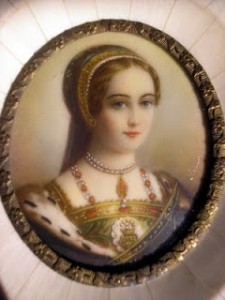As I continued to read Holinshed’s Chronicles I found others as well and became intrigued by Jane Grey, namely due to the brevity of her reign. Even as I knew of her, I constantly forgot about her nine days on the throne and would often skip from Edward VI to Mary in the line of succession.
While her nine days were short and she obviously had little time to make or change any policies, I nevertheless think she played an important role in English history. Mary’s succession had long been established by Henry’s various Acts of Succession and Will to follow Edward’s reign, should he have no children. Considering how sickly the young man was, he would undoubtably have none and on his deathbed the entire line of succession changed, cutting Mary and Elizabeth out while inserting Jane Grey, Edward’s cousin. There are stipulations as to whether the Duke of Northumberland really had anything to do with implanting the idea in Edward. While there is not much concrete evidence, common sense would suggest he did; Jane Grey was married to his son. And as the Duke’s lineage had no claims to the throne, by first marrying his son to Jane, and then thrusting her onto the throne (as she did have legitimate rights), his line would rule. Not to mention Jane was hardly older than Edward, and would need guidance in ruling England that Northumberland would conveniently provide. Yet, whether or not one would argue that Northumberland had anything to do with it is hardly the point.
While Mary was popular with the people and would have been welcomed nonetheless, in Jane’s interceding and what many would have called “usurping” the throne, she helped bolster Mary’s popularity further. As Mary rallied her supporters in the north (highly Catholic territory), she was able to march on London within only a few days of Jane’s coronation and take back the throne with many cheering her on. In short, while Mary knew she had the popular vote, such a threat to her crown instilled even more support from her followers, and gave her the confidence in her reign necessary to the drastic national and religious changes she would make during her five year reign. Without doubt she had long been planning policies, especially the religious rule of the land that would once again turn Catholic, but with an absolute affirmation of the people’s support she was able to implement her decrees immediately rather than finding the most diplomatic way of pursuing her goals. In other words, she was not afraid of losing the people’s favor when deciding to burn hundreds at the stake.
Further, her absolutist methods of ruling paved the way for Elizabeth’s more rational reign. And while most of this is speculative and relegated to the “what if” category since we obviously cannot determine if the same outcome would have been had if Jane was not on the throne for those nine days, it can’t but be noted that the mere act of placing her there inspired a greater series of events, effecting rulers to come, not to mention Jane’s kin who were for the most part all executed shorty after her and her husband.
It is therefore no wonder that Jane Grey has inspired a series of books, both scholarly and otherwise, along with films and plays. She may have been only an incidental character, but her appearance was the catalyst of many things to come.






